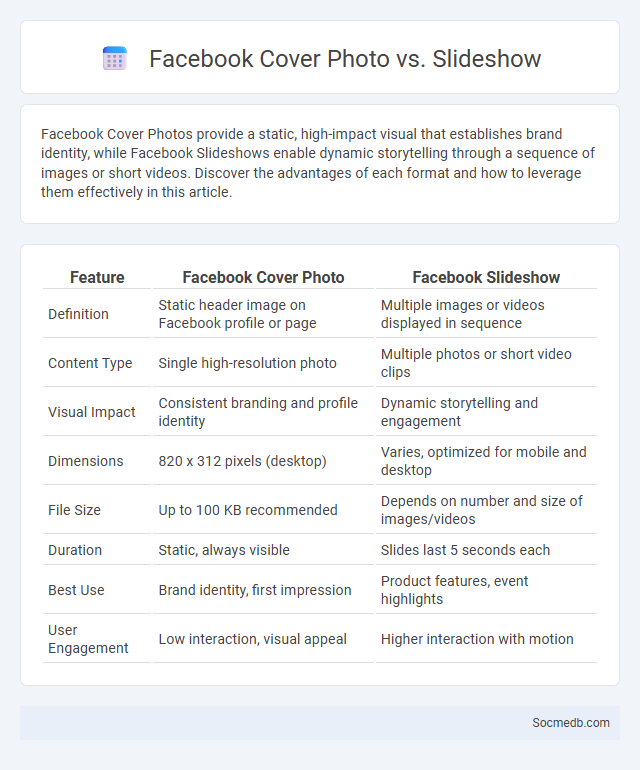
Photo illustration: Facebook Cover Photo vs Slideshow
Facebook Cover Photos provide a static, high-impact visual that establishes brand identity, while Facebook Slideshows enable dynamic storytelling through a sequence of images or short videos. Discover the advantages of each format and how to leverage them effectively in this article.
Table of Comparison
| Feature | Facebook Cover Photo | Facebook Slideshow |
|---|---|---|
| Definition | Static header image on Facebook profile or page | Multiple images or videos displayed in sequence |
| Content Type | Single high-resolution photo | Multiple photos or short video clips |
| Visual Impact | Consistent branding and profile identity | Dynamic storytelling and engagement |
| Dimensions | 820 x 312 pixels (desktop) | Varies, optimized for mobile and desktop |
| File Size | Up to 100 KB recommended | Depends on number and size of images/videos |
| Duration | Static, always visible | Slides last 5 seconds each |
| Best Use | Brand identity, first impression | Product features, event highlights |
| User Engagement | Low interaction, visual appeal | Higher interaction with motion |
Understanding Facebook Cover Photo Formats
Facebook cover photo formats require a 820 x 312 pixels resolution for optimal desktop display and 640 x 360 pixels for mobile devices, ensuring seamless visual appeal across all platforms. Using high-resolution images in JPG or PNG formats with an sRGB color profile maintains clarity and color accuracy. Proper aspect ratio and file size under 100 KB enhance loading speed and user experience, boosting engagement on Facebook profiles and pages.
What is a Facebook Cover Photo?
A Facebook cover photo is the large banner image displayed at the top of a user's profile or page, designed to visually represent personal identity or brand messaging. Its dimensions are typically 820 pixels wide by 312 pixels tall on desktops, ensuring optimal display across devices. This visual element enhances engagement by providing an immediate, impactful impression to visitors.
Introduction to Facebook Cover Slideshow
Facebook Cover Slideshow allows you to create a dynamic visual presentation on your profile, showcasing up to five images that rotate automatically. This feature enhances your page's engagement by providing an interactive and refreshing way to highlight important aspects of your personal brand or business. You can easily customize your slideshow to reflect your style, making your profile more appealing and memorable to visitors.
Key Differences: Cover Photo vs Slideshow
A cover photo provides a static, high-impact visual that defines your social media profile's primary aesthetic and branding, while a slideshow offers dynamic, multi-image content designed to engage viewers with varied storytelling. Your cover photo remains consistently visible at the top of your profile, making it essential for first impressions, whereas slideshows rotate within posts or stories, capturing attention through movement and multiple perspectives. Choosing between these elements depends on whether you want to establish a strong visual identity instantly or share diverse content that encourages ongoing interaction.
Visual Impact: Static vs Dynamic Covers
Visual impact plays a critical role in social media engagement, with static covers offering clear, focused imagery that quickly communicates brand identity. Dynamic covers, such as animated or video headers, enhance viewer interaction by delivering motion-driven storytelling and capturing attention through movement. Brands leveraging dynamic covers report increased click-through rates and longer profile visits compared to static alternatives.
Design Best Practices for Each Option
Social media platforms each have unique design best practices that maximize engagement and brand impact. On Instagram, prioritize high-quality visuals with consistent color schemes and minimal text to capture your audience's attention quickly. Your content on Twitter should focus on concise messaging paired with compelling visuals or infographics to enhance shareability and clarity.
Engagement Rate: Which Gets More Attention?
Engagement rate on social media is a critical metric measuring user interaction through likes, comments, shares, and clicks relative to follower count or impressions. Platforms like Instagram and TikTok typically achieve higher engagement rates due to visual content and algorithmic promotion of trending posts. Brands and influencers focusing on authentic interactions and timely responses often see increased attention and sustained engagement from their audience.
Branding Opportunities on Cover Media
Cover media on social platforms serves as a prime branding opportunity, allowing You to showcase your brand's identity through visually striking elements like cover photos and videos. Optimized cover media enhances brand recognition by consistently displaying logos, taglines, and key messages at the top of profiles, capturing audience attention instantly. Leveraging these prime digital real estate spots drives engagement and reinforces Your brand presence across social networks.
Mobile vs Desktop Display Considerations
Mobile social media usage demands responsive design that prioritizes vertical scrolling, faster load times, and touch-friendly interfaces due to smaller screen sizes and varied network conditions. Desktop displays allow for complex layouts with multiple columns, richer media integration, and detailed content presentation enhanced by larger screens and more precise cursor navigation. Optimizing content for each platform improves user engagement by addressing device-specific behavior and display capabilities.
Choosing the Right Option for Your Business
Selecting the appropriate social media platform depends on your business goals, target audience demographics, and content style. Instagram excels for visual-driven brands targeting younger demographics, while LinkedIn suits B2B companies seeking professional networking and industry engagement. Analyzing metrics such as engagement rates and conversion potential on Facebook, Twitter, or TikTok helps optimize campaign performance and maximize ROI.
 socmedb.com
socmedb.com